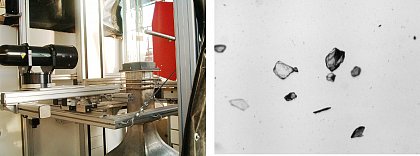Non spherical particles
Title:
Investigation and modelling of the behaviour of non-spherical particles in turbulent flows
Head:
Prof. Dr.-Ing. M. Sommerfeld
Staff:
Dipl.-Ing. Mathias Dietzel
Keywords:
Non-spheical particles, wall collisions, modelling, tuburlent flow
Description:
In the scope of the proposed research project the Euler/Lagrange approach for numerical calculation of particle laden flows has to be expanded to the consideration of non-spherical particles. This includes that the models have to be modified and extended for the description of particle motion in turbulence, for the calculation of wall collisions, as well as for particle collisions of non-spherical particles. Besides, it has to be tested to what extent the flow and especially the turbulence will be modified by particle shape. Particularly, for some special particle shapes, e.g. granulates or cylindrical particles, a considerable influence of the rotation must be expected. Particle collisions as well as the influence on turbulence will be objects of the second application period. A detailed experimental analysis of the relevant micro-processes (particle motion in turbulence and wall collisions) is necessary in the scope of this project because there are only few information available in the literature about the behaviour of non-spherical particles in turbulent flows. Besides, experimental data for validation of the new models are required.
For the experimental works planned two experimental facilities exist. In a vertical upward directed grid turbulence the motion behaviour of different non-spherical particles can be investigated. The experiments in a horizontal flat channel will be mainly limited to the analysis of wall impacts using cinematographic PIV. For modelling the motion of non-spherical particles in turbulent flows two approaches should be followed. On the one hand, a drag coefficient modified corresponding to the particle shape (e.g. also in dependence on a shape factor), which can be superimposed by a stochastic variation, will be used. For the second case, which is especially suitable for granulates and cylindrical particles, a further motion equation for the particle orientation has to be solved. The drag and the lateral force will be obtained by corresponding projection of the resulting forces in the major axes of the stock. The calculation of the wall collision process is based on the solution of the momentum equations in connection with the Coulomb friction law. Statistical parameters for the modelling of impact orientation will be obtained by kinematic simulations. For the validation of the wall collision model the results from the flat channel will be used.

Experimental setup and particle





